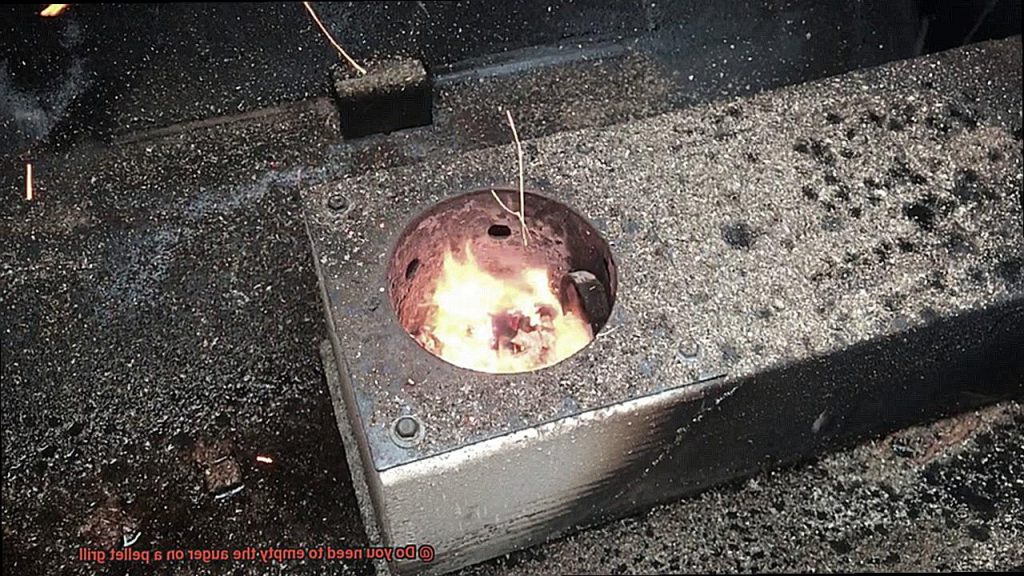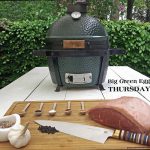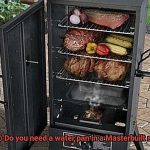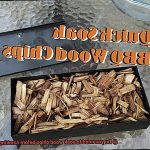Imagine this: a warm summer day, the sun shining bright, and the tantalizing aroma of grilled meat wafting through the air. You’re all set to cook up a storm on your pellet grill, but as you begin prepping your grill, you notice a pile of pellets left in the auger. The question pops into your mind – do you need to empty the auger on a pellet grill?
It’s a common query among pellet grill owners, and not knowing the answer can lead to costly mistakes and unsatisfactory cooking results. Pellet grilling is an easy and convenient way to cook, but understanding your grill’s mechanics is crucial.
In this blog post, we’ll dive deep into the world of pellet grilling and explore whether or not you should empty your auger before each cook. We’ll take a closer look at what an auger is, how it works, and why keeping it clean is essential. We’ll also discuss how often you should empty it and what happens when you don’t.
By the end of this post, you’ll have all the information you need to keep your pellet grill running smoothly and producing mouth-watering meals every time. So let’s get started.
Contents [show]
How Often Should You Empty the Auger?
This small but essential part is responsible for feeding pellets into the firepot, which means it can accumulate debris and ash over time. Neglecting to clean the auger can lead to issues with your grill’s performance and even pose a fire hazard in extreme cases.
So how often should you empty the auger? The answer will depend on various factors, including the frequency of use, the type of pellets used, and grilling conditions. Generally, it’s recommended that you empty the auger after every 20 hours of use or once a month, whichever comes first. Here are some key subtopics to consider:
Frequency of Use:
If you’re an avid griller who uses their pellet grill frequently and for long periods of time, you may need to empty the auger more often than someone who only grills occasionally. It’s crucial to keep an eye on your grill and check the auger regularly for any build-up.
Type of Pellets Used:
Different types of pellets produce varying amounts of ash, which can impact how often you need to empty the auger. High-ash pellets will lead to a build-up in the auger more quickly than low-ash pellets. Therefore, if you use high-ash pellets, it’s a good idea to empty your auger more frequently.
Grilling Conditions:
The conditions in which you are grilling can also affect how often you need to empty the auger. If you’re grilling in particularly dusty or humid conditions, for example, you may need to empty the auger more often than if you were grilling in ideal conditions.
Ultimately, it’s better to be safe than sorry when it comes to cleaning your pellet grill’s auger. If you notice that your pellets are not feeding into the firepot as quickly as they should be or getting stuck in the auger, it may be time to empty it out. Additionally, keeping an eye on the amount of ash accumulating in the firebox can indicate when it’s time to clean out the auger.
Factors That Affect How Often You Need to Empty the Auger
And while it’s recommended to empty the auger after every 20 hours of use or once a month, there are several other factors to consider that can affect how often you need to do this.
Let’s dive into these factors. First, the size of your hopper plays a significant role. If you have a larger hopper, it will hold more pellets and take longer to empty, which means you won’t need to empty the auger as frequently as someone with a smaller hopper. So, if you’re lucky enough to have a larger hopper, you can enjoy longer grilling sessions without worrying about emptying the auger too often.
Another factor to consider is how often you use your pellet grill. If you’re an avid griller who uses it frequently, you may need to empty the auger more often than someone who only uses their grill occasionally. The more you use your grill, the more pellets it will consume, and the more frequently you will need to refill the hopper and empty the auger.
The type of pellets you use can also affect how often you need to empty the auger. Different types of pellets have different densities and burn rates, which can impact how quickly they are consumed and how often you need to refill the hopper. For instance, hardwood pellets burn slower than softwood pellets. So if you use hardwood pellets, you may not need to empty the auger as frequently. However, it’s worth experimenting with different types of pellets to see what works best for your specific grill and preferences.
Lastly, environmental factors such as temperature and humidity can also impact how often you need to empty the auger. In humid climates or environments, pellets may absorb moisture and become clumpy, leading them to burn less efficiently and potentially clogging the auger. Similarly, in very cold temperatures, pellets may not burn as efficiently, causing them to accumulate in the hopper and potentially clogging the auger.
Frequency of Use
One often overlooked aspect of maintenance is understanding how frequently to empty the auger on your pellet grill. Let’s delve deeper into this topic and explore the different factors that affect it.
First and foremost, the frequency of use is a critical factor to consider. If you use your pellet grill on a regular basis, it is highly recommended that you empty the auger at least once a month or every 20 hours of cooking time. This will help prevent any potential build-up of wood dust or pellets in the auger, which could lead to clogs and malfunctions. However, if you only use your pellet grill occasionally, such as a few times a year, then it may not be necessary to empty the auger as often. In this case, it may be sufficient to simply clean the hopper and auger before each use to remove any residual debris.
Another factor that affects how often you need to empty the auger is the type of pellets used. Some pellets tend to produce more dust than others, which can increase the likelihood of clogs and malfunctions. If you’re using pellets that produce a lot of dust, it may be necessary to empty the auger more frequently. It’s always best to check with your manufacturer’s recommendations for specific guidelines.
Moreover, having a larger hopper can also affect how often you need to empty the auger. With a larger hopper, you can enjoy longer grilling sessions without worrying about emptying the auger too often. However, this is only true if you’re also using pellets that produce less dust.
Type of Pellets Used
In fact, it’s important to understand the differences between hardwood and softwood pellets, so you can make an informed decision about which is best for your needs.
Let’s start with hardwood pellets. These are a popular choice for those who want a bold, smoky flavor in their food. However, they do tend to produce more ash and debris than other types of pellets. This means that if you opt for hardwood pellets, you may need to clean out your grill’s auger more frequently to avoid blockages that could cause feeding issues.
On the other hand, softwood pellets are less likely to produce ash and debris, making them an excellent option for those who want to reduce maintenance requirements. However, they may not provide as intense a flavor as hardwood pellets.
Ultimately, the choice of which pellets to use will depend on your personal preference and the desired outcome for your food. If you’re willing to put in a bit of extra effort to keep your grill clean, then hardwood pellets are likely to give you that delicious smoky taste you crave. But if maintenance is a concern, then softwood pellets may be the way to go.
It’s worth noting that there are other types of pellets available as well. Some are made from sawdust or even food-grade soybeans. Each type of pellet has its own unique properties and can add its own distinct flavor profile to your food.
No matter which type of pellet you choose, it’s crucial to empty your grill’s auger regularly. This simple step can help prevent clogs and malfunctions caused by wood dust or pellet buildup.
Signs that Your Auger Needs to be Emptied
We all know how much we love our trusty grills, but it’s important to keep them in tip-top shape to ensure they’re performing at their best. Your grill’s auger is no exception – it’s essential to know when it needs to be emptied. Here are the top five signs that you need to look out for:
- Difficulty starting the fire: Starting your grill shouldn’t be a hassle. If you’re having trouble getting your grill started, it could be due to a full auger. The pellets may not be feeding into the firepot correctly, which can cause the flame to go out or not start at all. Avoid ruining your cookout and check your auger before lighting up.
- Uneven temperature: A well-cooked meal needs an even temperature throughout the cooking process. If you’ve noticed that the temperature inside your grill is fluctuating or not consistent, a full auger may be the culprit. The pellets may not be feeding into the firepot evenly, causing hot and cold spots inside the grill and resulting in unevenly cooked food.
- Slow pellet feed: We all know time is of the essence when it comes to grilling. If your pellets aren’t feeding into the firepot quickly enough, it could mean your auger is full or clogged. This delay can result in longer cooking times and unevenly cooked food.
- Pellet bridging: Pellets bridging inside the auger can cause a major inconvenience during your cookout. It happens when pellets stick together and form a bridge, preventing them from feeding into the firepot. This is usually caused by having too many pellets in the auger, so make sure to empty it regularly.
- Strange noises: A smooth and quiet grilling experience is what we all aim for, but strange noises like clicking, knocking, or grinding can ruin the vibe. These noises may be a sign that your auger is full or clogged and in need of an emptying.
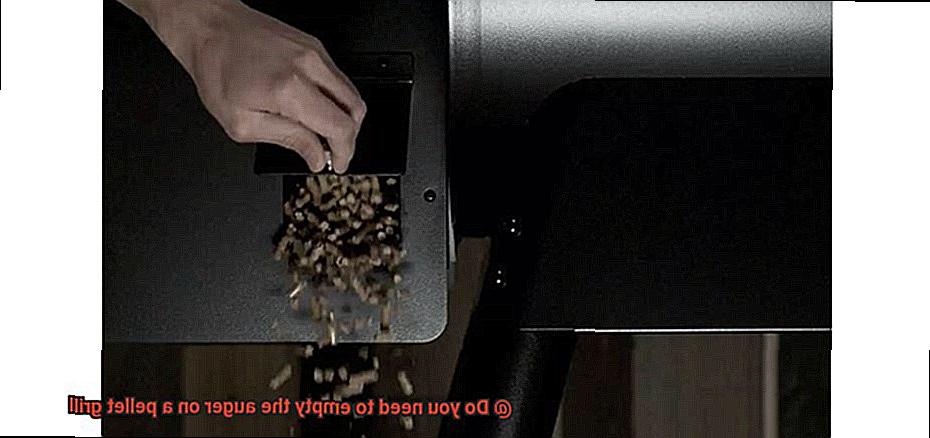
Steps for Emptying the Auger
Pellet grilling is undoubtedly one of the best ways to achieve mouthwatering flavors and succulent meats. However, to get the most out of your grilling experience, it’s essential to pay attention to the little things that make a big difference. One of those things is the auger.
The auger is responsible for delivering the pellets that fuel your grill. Over time, the auger can accumulate leftover pellets, dust, and debris, leading to clogs and uneven heating. Therefore, it’s crucial to empty the auger regularly to keep your pellet grill functioning optimally.
Here are the steps for emptying the auger on a pellet grill:
First things first, safety first. Turn off your pellet grill and unplug it from the power source. Next, remove any remaining pellets from the hopper using a scoop or vacuum. This will prevent them from falling into the auger tube during cleaning.
Now locate the auger motor and remove it from its housing. This will give you easy access to the auger. Using a vacuum or brush, gently remove any remaining pellets or debris from the auger tube. Make sure you don’t damage the tube while cleaning.
Once you’ve cleaned out all debris from the auger tube, reinsert the auger motor and secure it in place. Ensure that everything is tightly secured before proceeding.
Finally, plug in your pellet grill and turn it on to ensure that everything is working correctly. Run a test cycle to ensure that there are no clogs or blockages in the auger tube.
It’s recommended to empty your auger after every cooking session or at least once a month if you use your pellet grill frequently. Neglecting to do so can lead to clogs and uneven heating, which can ruin your cooking experience.
Benefits of Regularly Emptying the Auger
Here are some of the benefits of making this a regular part of your maintenance routine:
Smooth and Efficient Operation
Picture this: you’re in the middle of grilling up a storm, and suddenly your grill stops heating evenly, or worse, stops working altogether. A clogged auger could be to blame for this frustrating experience. Regularly emptying the auger of leftover pellets, dust, and debris ensures that your grill operates smoothly and efficiently, minimizing the risk of malfunctions or breakdowns.
Maintains Quality and Flavor of Food
The taste of your food is the ultimate goal when it comes to grilling. But did you know that leaving pellets in the auger for too long can impact the flavor of your food? Stale or moldy pellets can negatively affect the taste of your grilled meats. Additionally, any moisture or condensation in the auger can cause pellets to clump together, creating inconsistent heat and resulting in uneven cooking. By regularly emptying the auger, you maintain the quality and flavor of your food, ensuring that every bite is as delicious as possible.
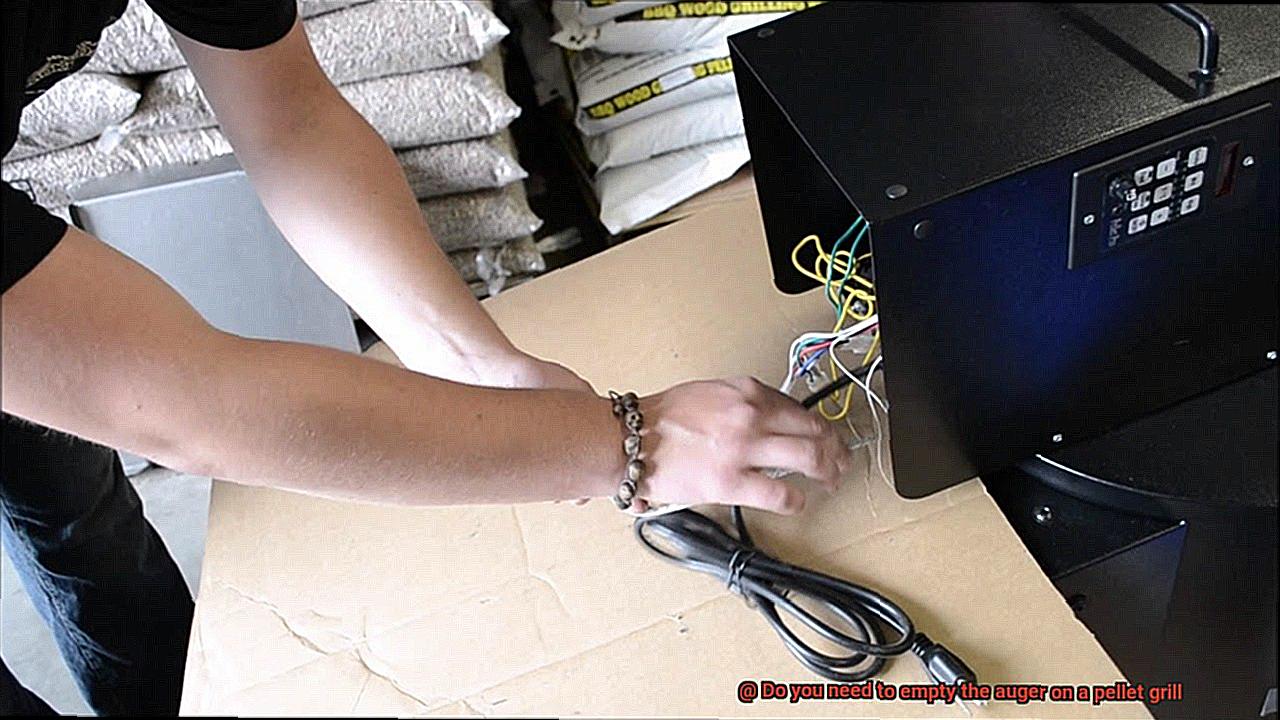
Prolongs Life of Your Grill
Pellet grills are a significant investment, so it’s essential to take care of them properly. By regularly emptying the auger and other components, you can prevent premature wear and tear on your grill while avoiding costly repairs or replacements.
Potential Problems if You Don’t Empty the Auger Regularly
The auger is the component that feeds pellets into the firepot to create heat, and neglecting to empty it can lead to a host of potential problems.
First and foremost, a clogged auger can cause your grill to malfunction, preventing it from reaching the desired temperature or even turning on at all. Imagine the frustration of hungry guests waiting for their food while you struggle with a faulty grill.
But that’s not all – neglected augers can also result in moisture buildup inside the grill, leading to corrosion and rust that can damage internal components and create unsanitary mold growth. This is not only unpleasant but also a health hazard.
In addition, failing to empty your auger regularly can result in uneven burning and hot or cold spots on your grill grates. This can lead to undercooked or overcooked food, ruining your efforts in the kitchen.
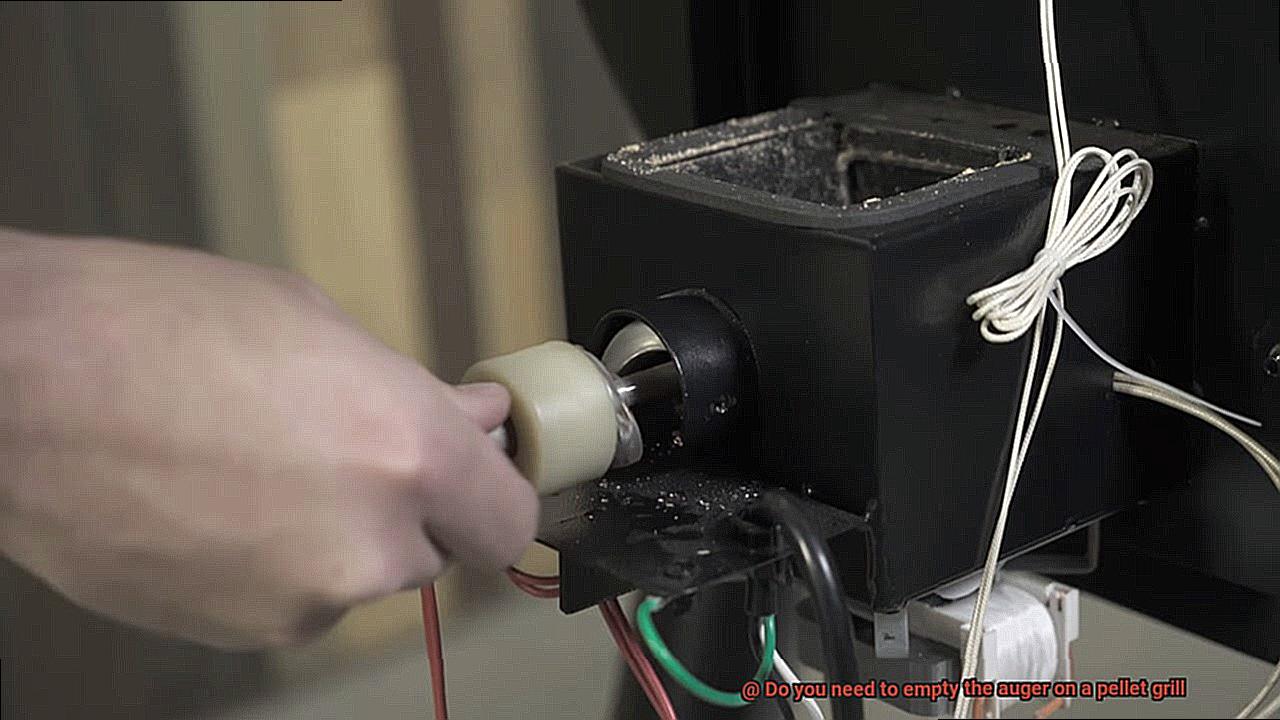
Finally, leaving pellets in the auger for too long can create a serious fire hazard. Pellets can ignite and cause a fire that could be dangerous if your grill is stored in an enclosed space or near flammable materials.
Common Mistakes When Emptying an Auger
It could be due to some common mistakes people make when emptying the auger. But don’t worry – we’ve got you covered with some expert tips to help you avoid these pitfalls and keep your grill running smoothly.
One of the biggest mistakes is not fully emptying the auger before adding new pellets. Leaving old pellets in the auger can lead to clogs and uneven feeding, which can affect the temperature and cooking performance of the grill. So take the time to clear out the old stuff before adding fresh pellets.
Another mistake people often make is neglecting to clean the auger regularly. Pellet grills generate ash and debris that can accumulate in the auger over time, causing clogs and other problems. So be sure to give your auger a good cleaning on a regular basis to prevent any buildup.
But here’s where things can get tricky: how do you clean the auger without damaging it? Using a vacuum or compressed air might seem like an easy solution, but it can actually cause more harm than good. Instead, use a soft-bristled brush or cloth to gently clean out any debris.
Last but not least, check the condition of your pellets before adding them to the grill. Old or low-quality pellets can break down and create dust that can clog up the auger just as effectively as any other debris. So make sure you’re using top-quality pellets that are in good condition.
sy8GZkWtRMI” >
Conclusion
In conclusion, keeping your pellet grill’s auger clean is crucial for achieving optimal performance and ensuring mouth-watering meals every time. Failing to do so can lead to clogs, uneven heating, and even pose a fire hazard in extreme cases. The frequency of emptying the auger will depend on various factors, including the type of pellets used, grilling conditions, and how often you use your grill. As a general rule of thumb, it’s recommended that you empty the auger after every 20 hours of use or once a month.
Regularly cleaning out your grill’s auger has numerous benefits. It helps maintain smooth and efficient operation while preserving the quality and flavor of your food. Neglecting to do so can cause potential problems such as malfunctioning grills, moisture buildup leading to corrosion and rust damage, uneven burning resulting in undercooked or overcooked food.
To avoid common mistakes when cleaning out your grill’s auger, make sure to fully empty it before adding new pellets. Also, regularly clean it with a soft-bristled brush or cloth and check the condition of your pellets before adding them to the grill. By following these tips and guidelines for properly maintaining your pellet grill’s auger, you’ll be able to enjoy delicious grilled meals for years to come without any hiccups.

